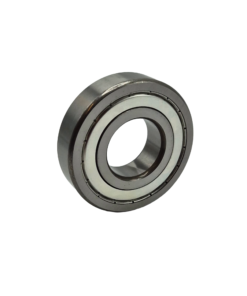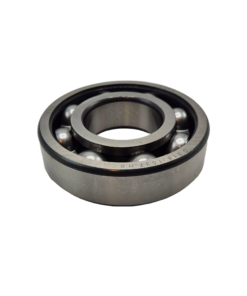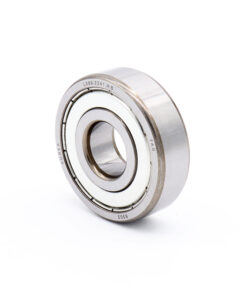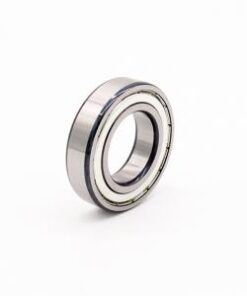Bearings
Bearings are parts between two bodies that move relative to each other. They support moving parts and reduce movement friction and vibration. They are found in almost all mechanical devices, such as cars.
Bearings can be divided into two main groups: sliding and rolling bearings. The function of plain bearings, such as spherical plain bearings, is based on sliding friction and they withstand both static and dynamic loads. The operation of rolling bearings, such as deep groove ball bearings, is based on the rolling friction generated by balls or rollers. The friction generated in them is small, and they are well suited for high rotational speeds.
The choice of bearings depends on the purpose of use and their requirements. It is important to choose the right bearing type and material so that the bearings work efficiently and last a long time. The type of equipment the bearing is used in and the type of load it must withstand affect the choice of bearing. The size and type of the load should also be taken into account. Heavier loads require stronger and more durable bearings. In some applications, it is also important to consider the damping properties of the bearing, in order to avoid problems caused by noise or vibration, for example.
Bearings are made of various materials, such as steel, rubber, plastic or ceramic materials. Steel bearings are the most common and are suitable for most applications. Rubber bearings are good at dampening noise and vibration. Plastic bearings are light. Ceramic bearings are very durable and are particularly suitable for high temperature applications. The selection must take into account the temperature and humidity of the bearing's operating environment, as well as the durability and efficiency required from the bearing. Bearing maintenance is an important factor in the efficient and durable operation of the device. A properly maintained bearing can improve the performance of the device and extend its life considerably. Bearing lubrication is usually necessary for rolling bearings in order for them to function without friction.Deep groove ball bearing 6300 series 2ZR is a high-quality bearing equipped with a durable metal shield. This bearing offers reliability and long service life in various industrial applications. It is designed to withstand demanding conditions and effectively reduce friction. The metal shield protects the bearing from dust and other contaminants, making it an excellent choice for demanding environments. Applications Industrial equipment, conveyor belts, electric motors, pumps Industries Automotive, manufacturing, energy, engineering Benefits Deep groove ball bearing 6300 series 2ZR offers excellent durability and performance, reducing the need for maintenance and improving equipment reliability. Risks Although the bearing is protected by a metal shield, its service life may be shortened if it is continuously exposed to extreme temperatures or humidity.
Deep groove ball bearing 6300 series 2ZR is a high-quality bearing equipped with a durable metal shield. This bearing offers reliability and long service life in various industrial applications. It is designed to withstand demanding conditions and effectively reduce friction. The metal shield protects the bearing from dust and other contaminants, making it an excellent choice for demanding environments. Applications Industrial equipment, conveyor belts, electric motors, pumps Industries Automotive, manufacturing, energy, engineering Benefits Deep groove ball bearing 6300 series 2ZR offers excellent durability and performance, reducing the need for maintenance and improving equipment reliability. Risks Although the bearing is protected by a metal shield, its service life may be shortened if it is continuously exposed to extreme temperatures or humidity.
Tapered roller bearing 30300 series is designed to provide reliable performance in various industrial applications. This bearing series is specially developed to withstand heavy loads and demanding operating conditions, making it an ideal choice for industrial applications. Its innovative design allows for effective lubrication and low friction, which extends the bearing's service life. The precise manufacturing process of the tapered roller bearing guarantees its reliability and quality. Applications Industrial equipment, mechanical engineering, conveyor lines, power transmission systems. Industries Metal industry, mining industry, automotive industry, energy production. Benefits The 30300 series tapered roller bearing offers long-life performance and reduced maintenance under heavy loads. Its precise and durable design enables reliable operation in demanding industrial environments. Risks If installed or maintained incorrectly, the service life of the bearing can be significantly reduced. In addition, the ingress of contaminants into the bearing can cause malfunctions and damage. Chemical resistance The tapered roller bearing is resistant to most industrial lubricants and solvents, but it is recommended to check compatibility with specific chemicals.
Deep groove ball bearing 6300 series C3 is designed to withstand demanding industrial conditions. This premium bearing is plastic-encased, providing excellent protection against dust and moisture. The bearing's C3 clearance allows for improved performance at high temperatures and speeds. It is the ideal solution when reliability and longevity are required. Applications Electric motors, conveyor systems, pumps, industrial gearboxes Industries Automotive industry, food industry, paper industry, engineering industry Benefits Deep groove ball bearing 6300 series C3 offers excellent durability and low maintenance requirements, improving machine reliability and reducing downtime. Risks If installed incorrectly, the bearing's performance may be reduced, which can lead to premature wear. Poor operating conditions, such as excessive moisture or dirt, can shorten the bearing's service life. Chemical resistance Thanks to the plastic protection, the bearing is resistant to most industrial chemicals, but it can be damaged by highly corrosive substances.
Deep groove ball bearing 6300 series C3 is designed to withstand demanding industrial conditions. This premium bearing is plastic-encased, providing excellent protection against dust and moisture. The bearing's C3 clearance allows for improved performance at high temperatures and speeds. It is the ideal solution when reliability and longevity are required. Applications Electric motors, conveyor systems, pumps, industrial gearboxes Industries Automotive industry, food industry, paper industry, engineering industry Benefits Deep groove ball bearing 6300 series C3 offers excellent durability and low maintenance requirements, improving machine reliability and reducing downtime. Risks If installed incorrectly, the bearing's performance may be reduced, which can lead to premature wear. Poor operating conditions, such as excessive moisture or dirt, can shorten the bearing's service life. Chemical resistance Thanks to the plastic protection, the bearing is resistant to most industrial chemicals, but it can be damaged by highly corrosive substances.
Deep groove ball bearing 6300 series C3 is designed to withstand demanding industrial conditions. This premium bearing is plastic-encased, providing excellent protection against dust and moisture. The bearing's C3 clearance allows for improved performance at high temperatures and speeds. It is the ideal solution when reliability and longevity are required. Applications Electric motors, conveyor systems, pumps, industrial gearboxes Industries Automotive industry, food industry, paper industry, engineering industry Benefits Deep groove ball bearing 6300 series C3 offers excellent durability and low maintenance requirements, improving machine reliability and reducing downtime. Risks If installed incorrectly, the bearing's performance may be reduced, which can lead to premature wear. Poor operating conditions, such as excessive moisture or dirt, can shorten the bearing's service life. Chemical resistance Thanks to the plastic protection, the bearing is resistant to most industrial chemicals, but it can be damaged by highly corrosive substances.
Deep groove ball bearing 6300 series C3 is designed to withstand demanding industrial conditions. This premium bearing is plastic-encased, providing excellent protection against dust and moisture. The bearing's C3 clearance allows for improved performance at high temperatures and speeds. It is the ideal solution when reliability and longevity are required. Applications Electric motors, conveyor systems, pumps, industrial gearboxes Industries Automotive industry, food industry, paper industry, engineering industry Benefits Deep groove ball bearing 6300 series C3 offers excellent durability and low maintenance requirements, improving machine reliability and reducing downtime. Risks If installed incorrectly, the bearing's performance may be reduced, which can lead to premature wear. Poor operating conditions, such as excessive moisture or dirt, can shorten the bearing's service life. Chemical resistance Thanks to the plastic protection, the bearing is resistant to most industrial chemicals, but it can be damaged by highly corrosive substances.
Deep groove ball bearing 6300 series C3 is designed to withstand demanding industrial conditions. This premium bearing is plastic-encased, providing excellent protection against dust and moisture. The bearing's C3 clearance allows for improved performance at high temperatures and speeds. It is the ideal solution when reliability and longevity are required. Applications Electric motors, conveyor systems, pumps, industrial gearboxes Industries Automotive industry, food industry, paper industry, engineering industry Benefits Deep groove ball bearing 6300 series C3 offers excellent durability and low maintenance requirements, improving machine reliability and reducing downtime. Risks If installed incorrectly, the bearing's performance may be reduced, which can lead to premature wear. Poor operating conditions, such as excessive moisture or dirt, can shorten the bearing's service life. Chemical resistance Thanks to the plastic protection, the bearing is resistant to most industrial chemicals, but it can be damaged by highly corrosive substances.
Deep groove ball bearing 6300 series C3 is designed to withstand demanding industrial conditions. This premium bearing is plastic-encased, providing excellent protection against dust and moisture. The bearing's C3 clearance allows for improved performance at high temperatures and speeds. It is the ideal solution when reliability and longevity are required. Applications Electric motors, conveyor systems, pumps, industrial gearboxes Industries Automotive industry, food industry, paper industry, engineering industry Benefits Deep groove ball bearing 6300 series C3 offers excellent durability and low maintenance requirements, improving machine reliability and reducing downtime. Risks If installed incorrectly, the bearing's performance may be reduced, which can lead to premature wear. Poor operating conditions, such as excessive moisture or dirt, can shorten the bearing's service life. Chemical resistance Thanks to the plastic protection, the bearing is resistant to most industrial chemicals, but it can be damaged by highly corrosive substances.
Deep groove ball bearing 6300 series C3 is designed to withstand demanding industrial conditions. This premium bearing is plastic-encased, providing excellent protection against dust and moisture. The bearing's C3 clearance allows for improved performance at high temperatures and speeds. It is the ideal solution when reliability and longevity are required. Applications Electric motors, conveyor systems, pumps, industrial gearboxes Industries Automotive industry, food industry, paper industry, engineering industry Benefits Deep groove ball bearing 6300 series C3 offers excellent durability and low maintenance requirements, improving machine reliability and reducing downtime. Risks If installed incorrectly, the bearing's performance may be reduced, which can lead to premature wear. Poor operating conditions, such as excessive moisture or dirt, can shorten the bearing's service life. Chemical resistance Thanks to the plastic protection, the bearing is resistant to most industrial chemicals, but it can be damaged by highly corrosive substances.
Deep groove ball bearing 6300 series C3 is designed to withstand demanding industrial conditions. This premium bearing is plastic-encased, providing excellent protection against dust and moisture. The bearing's C3 clearance allows for improved performance at high temperatures and speeds. It is the ideal solution when reliability and longevity are required. Applications Electric motors, conveyor systems, pumps, industrial gearboxes Industries Automotive industry, food industry, paper industry, engineering industry Benefits Deep groove ball bearing 6300 series C3 offers excellent durability and low maintenance requirements, improving machine reliability and reducing downtime. Risks If installed incorrectly, the bearing's performance may be reduced, which can lead to premature wear. Poor operating conditions, such as excessive moisture or dirt, can shorten the bearing's service life. Chemical resistance Thanks to the plastic protection, the bearing is resistant to most industrial chemicals, but it can be damaged by highly corrosive substances.
Deep groove ball bearing 6300 series C3 is designed to withstand demanding industrial conditions. This premium bearing is plastic-encased, providing excellent protection against dust and moisture. The bearing's C3 clearance allows for improved performance at high temperatures and speeds. It is the ideal solution when reliability and longevity are required. Applications Electric motors, conveyor systems, pumps, industrial gearboxes Industries Automotive industry, food industry, paper industry, engineering industry Benefits Deep groove ball bearing 6300 series C3 offers excellent durability and low maintenance requirements, improving machine reliability and reducing downtime. Risks If installed incorrectly, the bearing's performance may be reduced, which can lead to premature wear. Poor operating conditions, such as excessive moisture or dirt, can shorten the bearing's service life. Chemical resistance Thanks to the plastic protection, the bearing is resistant to most industrial chemicals, but it can be damaged by highly corrosive substances.
Deep groove ball bearing 6300 series C3 is designed to withstand demanding industrial conditions. This premium bearing is plastic-encased, providing excellent protection against dust and moisture. The bearing's C3 clearance allows for improved performance at high temperatures and speeds. It is the ideal solution when reliability and longevity are required. Applications Electric motors, conveyor systems, pumps, industrial gearboxes Industries Automotive industry, food industry, paper industry, engineering industry Benefits Deep groove ball bearing 6300 series C3 offers excellent durability and low maintenance requirements, improving machine reliability and reducing downtime. Risks If installed incorrectly, the bearing's performance may be reduced, which can lead to premature wear. Poor operating conditions, such as excessive moisture or dirt, can shorten the bearing's service life. Chemical resistance Thanks to the plastic protection, the bearing is resistant to most industrial chemicals, but it can be damaged by highly corrosive substances.
Deep groove ball bearing 6300 series C3 is designed to withstand demanding industrial conditions. This premium bearing is plastic-encased, providing excellent protection against dust and moisture. The bearing's C3 clearance allows for improved performance at high temperatures and speeds. It is the ideal solution when reliability and longevity are required. Applications Electric motors, conveyor systems, pumps, industrial gearboxes Industries Automotive industry, food industry, paper industry, engineering industry Benefits Deep groove ball bearing 6300 series C3 offers excellent durability and low maintenance requirements, improving machine reliability and reducing downtime. Risks If installed incorrectly, the bearing's performance may be reduced, which can lead to premature wear. Poor operating conditions, such as excessive moisture or dirt, can shorten the bearing's service life. Chemical resistance Thanks to the plastic protection, the bearing is resistant to most industrial chemicals, but it can be damaged by highly corrosive substances.
Deep groove ball bearing 6300 series C3 is designed to withstand demanding industrial conditions. This premium bearing is plastic-encased, providing excellent protection against dust and moisture. The bearing's C3 clearance allows for improved performance at high temperatures and speeds. It is the ideal solution when reliability and longevity are required. Applications Electric motors, conveyor systems, pumps, industrial gearboxes Industries Automotive industry, food industry, paper industry, engineering industry Benefits Deep groove ball bearing 6300 series C3 offers excellent durability and low maintenance requirements, improving machine reliability and reducing downtime. Risks If installed incorrectly, the bearing's performance may be reduced, which can lead to premature wear. Poor operating conditions, such as excessive moisture or dirt, can shorten the bearing's service life. Chemical resistance Thanks to the plastic protection, the bearing is resistant to most industrial chemicals, but it can be damaged by highly corrosive substances.
Deep groove ball bearing 6200 series c3 is designed to withstand even the most demanding industrial conditions. This bearing is part of the high-quality FAG 6200 series and has a C3 clearance, making it an excellent choice for heavy duty applications and high loads. Its design ensures reliable performance and a long service life, reducing maintenance requirements and improving the efficiency of production processes. Its compact size makes it easy to install in a variety of applications. Applications Motors, pump shafts, conveyor systems, industrial machinery Industries Automotive industry, mechanical engineering, food industry, paper industry Benefits Deep groove ball bearing 6200 series c3 offers excellent durability and reliability, which improves machine life and reduces downtime. Risks If installed incorrectly, bearing performance may be compromised, leading to increased wear and failure.
Deep groove ball bearing 6200 series c3 is designed to withstand even the most demanding industrial conditions. This bearing is part of the high-quality FAG 6200 series and has a C3 clearance, making it an excellent choice for heavy duty applications and high loads. Its design ensures reliable performance and a long service life, reducing maintenance requirements and improving the efficiency of production processes. Its compact size makes it easy to install in a variety of applications. Applications Motors, pump shafts, conveyor systems, industrial machinery Industries Automotive industry, mechanical engineering, food industry, paper industry Benefits Deep groove ball bearing 6200 series c3 offers excellent durability and reliability, which improves machine life and reduces downtime. Risks If installed incorrectly, bearing performance may be compromised, leading to increased wear and failure.
Deep groove ball bearing 6200 series c3 is designed to withstand even the most demanding industrial conditions. This bearing is part of the high-quality FAG 6200 series and has a C3 clearance, making it an excellent choice for heavy duty applications and high loads. Its design ensures reliable performance and a long service life, reducing maintenance requirements and improving the efficiency of production processes. Its compact size makes it easy to install in a variety of applications. Applications Motors, pump shafts, conveyor systems, industrial machinery Industries Automotive industry, mechanical engineering, food industry, paper industry Benefits Deep groove ball bearing 6200 series c3 offers excellent durability and reliability, which improves machine life and reduces downtime. Risks If installed incorrectly, bearing performance may be compromised, leading to increased wear and failure.
Deep groove ball bearing 6200 series c3 is designed to withstand even the most demanding industrial conditions. This bearing is part of the high-quality FAG 6200 series and has a C3 clearance, making it an excellent choice for heavy duty applications and high loads. Its design ensures reliable performance and a long service life, reducing maintenance requirements and improving the efficiency of production processes. Its compact size makes it easy to install in a variety of applications. Applications Motors, pump shafts, conveyor systems, industrial machinery Industries Automotive industry, mechanical engineering, food industry, paper industry Benefits Deep groove ball bearing 6200 series c3 offers excellent durability and reliability, which improves machine life and reduces downtime. Risks If installed incorrectly, bearing performance may be compromised, leading to increased wear and failure.
Deep groove ball bearing 6200 series c3 is designed to withstand even the most demanding industrial conditions. This bearing is part of the high-quality FAG 6200 series and has a C3 clearance, making it an excellent choice for heavy duty applications and high loads. Its design ensures reliable performance and a long service life, reducing maintenance requirements and improving the efficiency of production processes. Its compact size makes it easy to install in a variety of applications. Applications Motors, pump shafts, conveyor systems, industrial machinery Industries Automotive industry, mechanical engineering, food industry, paper industry Benefits Deep groove ball bearing 6200 series c3 offers excellent durability and reliability, which improves machine life and reduces downtime. Risks If installed incorrectly, bearing performance may be compromised, leading to increased wear and failure.





